The Economics and Statistics Division maintains archives of previous publications for accountability purposes, but makes no updates to keep these documents current with the latest data revisions from Statistics Canada. As a result, information in older documents may not be accurate. Please exercise caution when referring to older documents. For the latest information and historical data, please contact the individual listed to the right.
<--- Return to Archive
For additional information relating to this article, please contact:
November 08, 2017PROVINCIAL ECONOMIC ACCOUNTS 2016 The Provincial Economic Accounts provide the official estimates of Nova Scotia's GDP and select indicators for 2016. The estimates released today include revisions for the years 2014 and 2015 and the first estimate of expenditure and income for 2016. Revisions for 2014 and 2015 for both real and nominal GDP were positive with increased levels of capital formation offsetting lower household consumption. The level of exports and import activity were revised down for both 2014 and 2015 by similar amounts, leaving nominal net trade slightly improved. Real GDP grew 1.1 per cent in 2014 (previously 0.8%) and 1.4 per cent in 2015 (previously 1.1%). Nominal GDP growth rates were revised from 1.7 per cent to 2.9 per cent in 2014 and from 2.4 per cent to 2.1 per cent in 2015.
In 2016, real gross domestic product (GDP) increased 1.4 per cent in Canada with eight provinces showing positive growth and Saskatchewan (-0.5%) and Alberta (-3.7%) with GDP declines. Nova Scotia grew at 0.8 per cent in 2016, a slower pace than the revised growth rates of 1.4 per cent in 2015 and 1.1 per cent in 2014. Growth was fastest in British Columbia at 3.5 per cent.
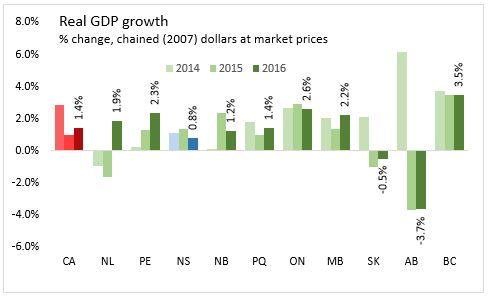
Real (adjusted for price changes) household consumption was up in all provinces except Alberta in 2016, growing by 2.4 per cent nationally. Growth in Nova Scotia was 1.3 per cent with the slowest growth in Alberta at -0.1 per cent and the fastest growth in British Columbia at 3.2 per cent. Government consumption expenditures were higher in all provinces.

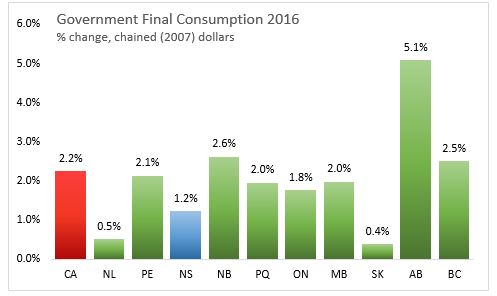
Residential structures grew 3.3 per cent nationally with growth in Ontario (+7.5%) and British Columbia (+15.0%) coming from robust housing markets in Toronto and Vancouver. Residential activity was also up in Nova Scotia (+5.5%) and Prince Edward Island and to a lesser extent New Brunswick (+1.5%). Investment in non-residential structures and machinery and equipment was up in the Atlantic region with investments in Hebron and Muskrat Falls in Newfoundland and Labrador, Interconnection Upgrade project in Prince Edward Island and Maritime Link and Touquoy gold mine in Nova Scotia. Lower oil prices negatively affected business investment in Western Canada.

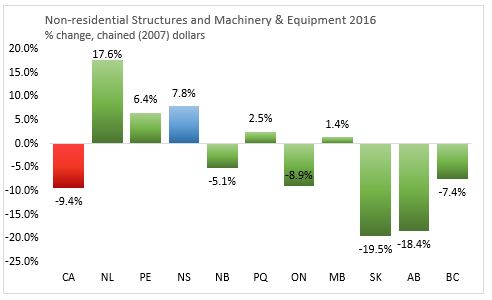

Exports of goods and services were up in eight provinces but down for Nova Scotia and Saskatchewan. Newfoundland and Labrador led with growth of 8.1 per cent followed by Ontario (+2.5%) and Prince Edward Island (+2.3%). Imports fell in Saskatchewan and Alberta while rising in six provinces, prominently in Newfoundland and Labrador (+10.0%).

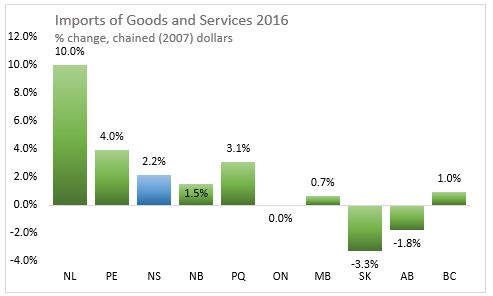
For 2016, nominal GDP (volumes and prices) grew 2.0 per cent in Canada and 2.8 per cent in Nova Scotia. Nominal GDP was down in Saskatchewan (-4.0%) and Alberta (-4.9%). British Columbia (+4.8%) and Ontario (+4.3%) registered the fastest nominal growth.
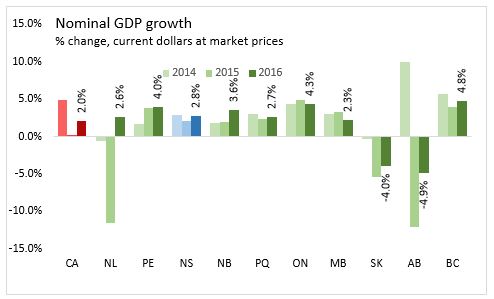
Employee compensation was up in all provinces except Alberta (-5.0%) and Saskatchewan (-1.1%). The fastest growth was in New Brunswick and British Columbia (both +3.8%). Nova Scotia employee compensation grew 1.8 per cent in 2016. Corporate operating surplus was up 16.9 per cent in Nova Scotia in 2016, stronger growth than all other provinces. Canada corporate net operating surplus fell 1.9 per cent with declines in Newfoundland and Labrador, Manitoba, Saskatchewan and Alberta.

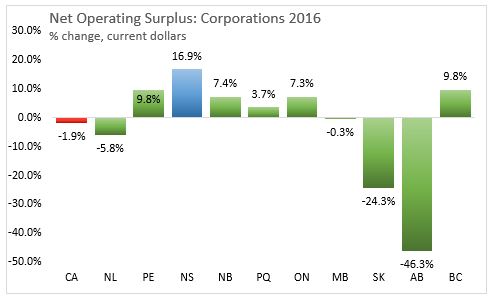
Source: Provincial and territorial economic accounts, 2016
<--- Return to Archive